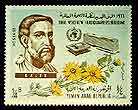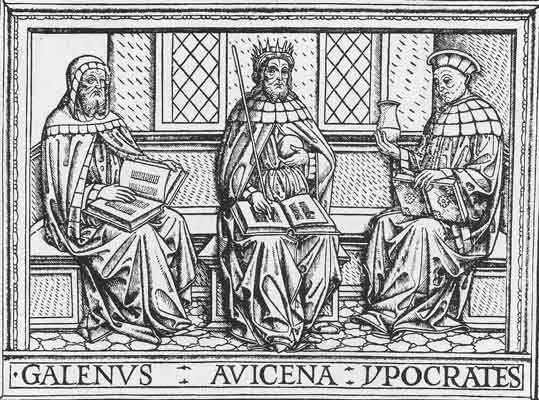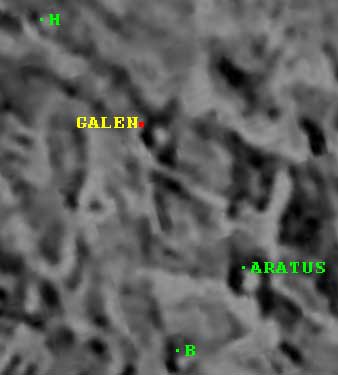.

Galen on a Greek Stamp.
Never as yet have I gone astray, whether in treatment or in prognosis, as have so many other physicians of great reputation. . . . Whoever seeks fame by deed, not alone by learned speech, need only become familiar, at small cost of trouble, with all that I have achieved by active research during the course of my entire life.
Galen
Galen (c. 130/1 AD - c. 199/201 AD, some say even that he died 217 AD) Greek philosopher-physician was born in Pergamon, a Greco-Roman town in Asia Minor. His father, Aelius Nicon, was an architect and builder with an interest in mathematics, logic, and astronomy and a fondness for exotic mathematical and literary recreations. His mother, according to Galen himself, was a hot-tempered woman, always arguing with his father; Galen compared her to Socrates' wife Xanthippe.
His father as Galen says wanted him to study philosophy but Asclepius intervened in a dream giving him the advice that Galen should study medicine as he did. After his fathers dead Galen, only 19 years old, was rich and independent. He chose to travel and further his medical education at Smyrna (today Izmir Turkey), Corinth, and Alexandria. In 157 he returned to his native city and a prestigious appointment: physician to the gladiators. From autumn 157 to autumn 161 he gained valuable practical experience in trauma and sports medicine, and he continued to pursue his studies in theoretical medicine and philosophy. Galen is referred as the father of sports medicine. He gave a good account of the skeleton and the muscles that move it. In particular, the way that signals are given from the brain through the nerves and to the muscles.
By 161 AD Galen realized that even a great and prosperous provincial city like Pergamum could not offer the opportunities his talents and ambition demanded. He left, returning only for a three-year span from 166 until some time in 169. The rest of his career was spent in Rome, where he rose quickly to fame with public demonstrations of anatomical and surgical skills. He became physician to the Roman emperor Marcus Aurelius and his ambitious son Commodus. In 166 AD the so-called plague of Antoninus or Galen killed around 2000 people each day in Rome and among these was Marcus Aurelius. His most famous diagnosis was that of “overindulgence” in the emperor himself, and he is also said to have collected a fee of four hundred gold pieces, fifteen times the going rate, for making a house-call on the wife of the Roman consul Flavius Boethius. It is estimated that he accumulated 20000000 sesterces ( 2 times more than the poet Vergil)
He published work is enormous. His more than twenty volumes printed text represents half of all Greek medical literature that is today available to us. 1821-33 – C.G. Kühn published 20 volumes of works of Galen in Greek text and Latin translation – Claudii Galeni opera omnia
The approximate 20000 pages of Galen's treatises have never had, as a whole, any critical edition; and it excludes numerous treatises which were not kept in Greek but in their translation. An important part of Galen's work has not come down to us or has been passed on only in the Latin, Arabic and very rarely Hebrew translations. Nearly entirely lost is the majority of his philosophical and ethical works as well as important commentaries on the treatises of Hippocrates. For example, on Hippocrates treatise "Upon air, water and situations", a treatise lost to us in Greek but surviving in Arabic. In fact, all kinds of situations coexist : some treatises, kept in Greek, have been translated both in Latin and Arabic; other ones, lost in Greek, have been preserved only in medieval Latin translations, as in the case of "Subfiguratio empirica" ; others have been kept only in Arabic, whereas some others still have been lost in Greek, Latin and Arabic.
WORK:
76 titles assumed authentic, 6 questionable, 21 probably discredited (1/3-2/3 of his total output). Many/most of his original manuscripts burned in fire at Temple of Peace in 191 AD

Galen on a Stamp from Yemen
A supporter of observation and reasoning, he was one of the first experimental physiologists, researching the function of the kidneys and the spinal cord in controlled experiments.
He found that:
- Arteries are filled with blood rather than the vague life providing substance inhaled into the body called pneuma
- Chest expansion from diaphragmatic and thoracic muscle action precede ventilation rather than the reverse
- Urine is formed by the kidneys, not the bladder
- The spinal cord and spinal nerves control specific neuromuscular functions
- Voice control originates in the recurrent laryngeal nerve, not in the heart
- The heart is the origin of blood vessels, and the brain the source of nerves, not the converse
- Sensory nerves are distinguishable from motor nerves
The Greek name of Galen “galenos” means calm and serene, qualities that do not describe Galen. He was anything but calm and serene, history depicting him as fiery and excitable and arrogant man. While he discovered many medical truths many of his opinions were wrong. Some of these errors can be attributed in part that he performed dissections on animals but not on humans that was not allowed. It was said that he dissected thousand of animals including dogs, pigs and even elephants. Part of the knowledge he obtained from studies of wounded and dead gladiators.
Physicians for the next 1500 years, adhered to these erroneous teachings of Galen. Only at the 16th century these mistaken notions were corrected by Vesalius, Harvey and others.
Paradoxically, the overthrow of Galenism in the Renaissance was due precisely to the rediscovery of Galen's methods by Vesalius (A.D. 1514-1564) and Harvey (A.D. 1578-1657). The medical scholars of the first half of the 16th century had returned to reading Galen in the original Greek. They emphasized his superiority over his later interpreters, stressing his learning and the centrality of anatomy in his view of medicine. Vesalius, while openly contemptuous of Galen, followed his advice and methodology to produce a new anatomy of the human body. Harvey, more conservative, repeated Galen's experiments to overthrow his tripartite system of physiology. The spirit of Galen can thus be said to have triumphed over his conclusions. Vivian Nutton
An example of Galen's writings with comments by Gert-Jan C. Lokhorst and Timo T. Kaitaro
In Galen's (129-ca.210 A.D.) On the usefulness of the parts of the body we find the following passage about the function of the pineal gland:
I believe that this gland resembling a pine cone and filling up the bifurcation of the large vein [v. cerebri magna (Galeni)] from which nearly all the choroid plexuses of the anterior ventricles arise was formed for the same usefulness as other glands that support veins as they divide. Indeed, its position is the same in every respect as that of such glands, for its apex is firmly established at those parts of the vein where it first divides [beneath the splenium of the corpus callosum]; all the rest of it increases in size to correspond with the distance between the vessels [vv. cerebri internae, veins of Galen] resulting from the division; and it proceeds as far as the vessels extend in a suspended condition. As soon as these veins pass onto the body of the encephalon itself [at the posterior boundary of the third ventricle], the pineal body abandons them, and the body of the encephalon in this region becomes a support for both the pineal body itself and the veins.
The notion that the pineal body is what regulates the passage of the pneuma is the opinion of those who are ignorant of the action of the vermiform epiphysis [vermis superior cerebelli] and who give more than due credit to this gland. Now if the pineal body were a part of the encephalon itself, as the pylorus is part of the stomach, its favorable location would enable it alternately to open and close the canal because it would move in harmony with the contractions and expansions of the encephalon. Since this gland, however, is by no means a part of the encephalon and is attached not to the inside but to the outside of the ventricle, how could it, having no motion of its own, have so great an effect on the canal? But perhaps some one will say, "What is to prevent it from having a motion of its own?" What, indeed, other than that if it had, the gland on account of its faculty and worth would have been assigned to us as an encephalon, and the encephalon itself would be only a body divided by many canals and would be like an instrument that was suited to be of service to a part formed by Nature to move and capable of doing so? Why need I mention how ignorant and stupid these opinions are? For this part, which people imagine must be a part of the encephalon itself near the canal, this part which must be such as to control and govern the passage of the pneuma and which they cannot discover, is not the pineal body but the epiphysis [vermis superior cerebelli] that is very like a worm and is extended along the whole canal. (Book VIII, ch.14; May, 1968, vol.I, pp.419-420.)
Thus, Galen regarded the pineal gland as a support for the blood vessels in its neighborhood. This idea was widely accepted until the eighteenth century. Even Vesalius (1543, p.638) did not object to it.
The idea that the vermis regulates the flow of spirit in the "canal" between the third and fourth ventricles was also accepted for a very long time. It fell out of favor after Vesalius (1543, p.216, p.639) had rejected it.
Galen about opium: (It) resists poison and venomous bites, cures chronic headache, vertigo, deafness, epilepsy, apoplexy, dimness of sight, loss of voice, asthma, coughs of all kinds, spitting of blood, tightness of breath, colic, the iliac poison, jaundice, hardness of the spleen, stone, urinary complaints, fevers, dropsies, leprosies, and the troubles to which women are subject, melancholy and all pestilences (Scott, Scott, J.M. The White Poppy. New York: Funk & Wagnells, 1969; 5, 46-82, 109-125).
Galen wrote that his teacher Aeschrion in Pergamon invented a medicine against the bite of a mad dog. The recipe was to use crawfish, caught only at a particular time based on the relative position of the moon and sun and the fish had to be baked alive.
Galen asking for a peer review of medical publications
It was a law in old Egypt that all inventions in handicrafts had to be judged by an assembly educated men and be written on pillars in a sacred place. Likewise, we should have an assembly just and equally well-educated men. They should scrutinize all that has been written, and deposit a public place only what appears worthwhile, destroy what is worthless, Galen, Against the Opinions of Julian Concerning the Aphorisms of Hippocrates Trans. R.E.Siegel, quoted by P.Prioreschi Roman Medicine, p. 327
Matthew Megill: Heart Failure. Why was the great Greek physician Galen unable to figure out that the heart circulated blood throughout the body? And even more to the point, does Galen’s failure to discern the heart’s true function hold any lessons for the scientists of today? (PDF File)
See also:
Galen on diseases and symptoms, Ian Johnston
Galen, On the properties of foodstuffs. O. W. Powell,J ohn Wilkins
Galen, Three treatises on the nature of science
Galen and the Gateway to Medicine, Jeanne Bendick
Other ancient Greek medical facts
Dioscorides
Hippocrates
Artemidorus
The illness of Antiochus
Dissections
Greek Medicine By Charles Singer
LINKS
Galen: On the Usefulness of Parts of the Body (part about the hand) (PDF File)
Galen: On the Usefulness of the Parts (The 14th Book, The Reproductive Tract) (PDF File)
Galen: On Hippocrates On the Nature of Man, A online book
The Hippocratic Tradition (PDF File 258 pages, 0.6 MB) , A critical review of the interpretation of the work of Hippocrates by Galen and others
GALEN HISTORY "MATERIA MEDICA"
Dreams in Ancient Medicine
Embryology: The Bible Plagiarises Ancient Greek Literature
Ancient Medicine (Sciences of Antiquity Series) London and New York: Routledge, 2004. Pp. xiv, 486; ills. 31, maps & plans 4. ISBN 0-415-08611-6
Works in Greek and Latin (Books as DJVU Files, requires a free available DJVU Viewer),
A History of Pharmacy : Robert Thom's Paintings
- Ancient Medicine (Sciences of Antiquity Series)- London and New York: Routledge, 2004. Pp. xiv, 486; ills. 31, maps & plans 4. ISBN 0-415-08611-6
- Marketos SG, Skiadas PK: Galen: a pioneer of spine research. Spine 24:2358-–2362, 1999
- Awad IA. Galen's anecdote of the fallen sophist: on the certainty of science through anatomy. J Neurosurg. 1995 Nov;83(5):929-32.
- Horstmanshoff HF. Galen and his patients. Clio Med. 1995;27:83-99.
- Viale GL. Return to Galen. Neurosurgery. 2003 Jul;53(1):205-10;
- El-Gammal SY. The role of Galen in the development and progress of medical sciences. Bull Indian Inst Hist Med Hyderabad. 1998 Jul;28(2):119-27.
| Ancient Greece
Science, Technology , Medicine , Warfare, , Biographies , Life , Cities/Places/Maps , Arts , Literature , Philosophy ,Olympics, Mythology , History , Images Medieval Greece / Byzantine Empire Science, Technology, Arts, , Warfare , Literature, Biographies, Icons, History Modern Greece Cities, Islands, Regions, Fauna/Flora ,Biographies , History , Warfare, Science/Technology, Literature, Music , Arts , Film/Actors , Sport , Fashion --- |



